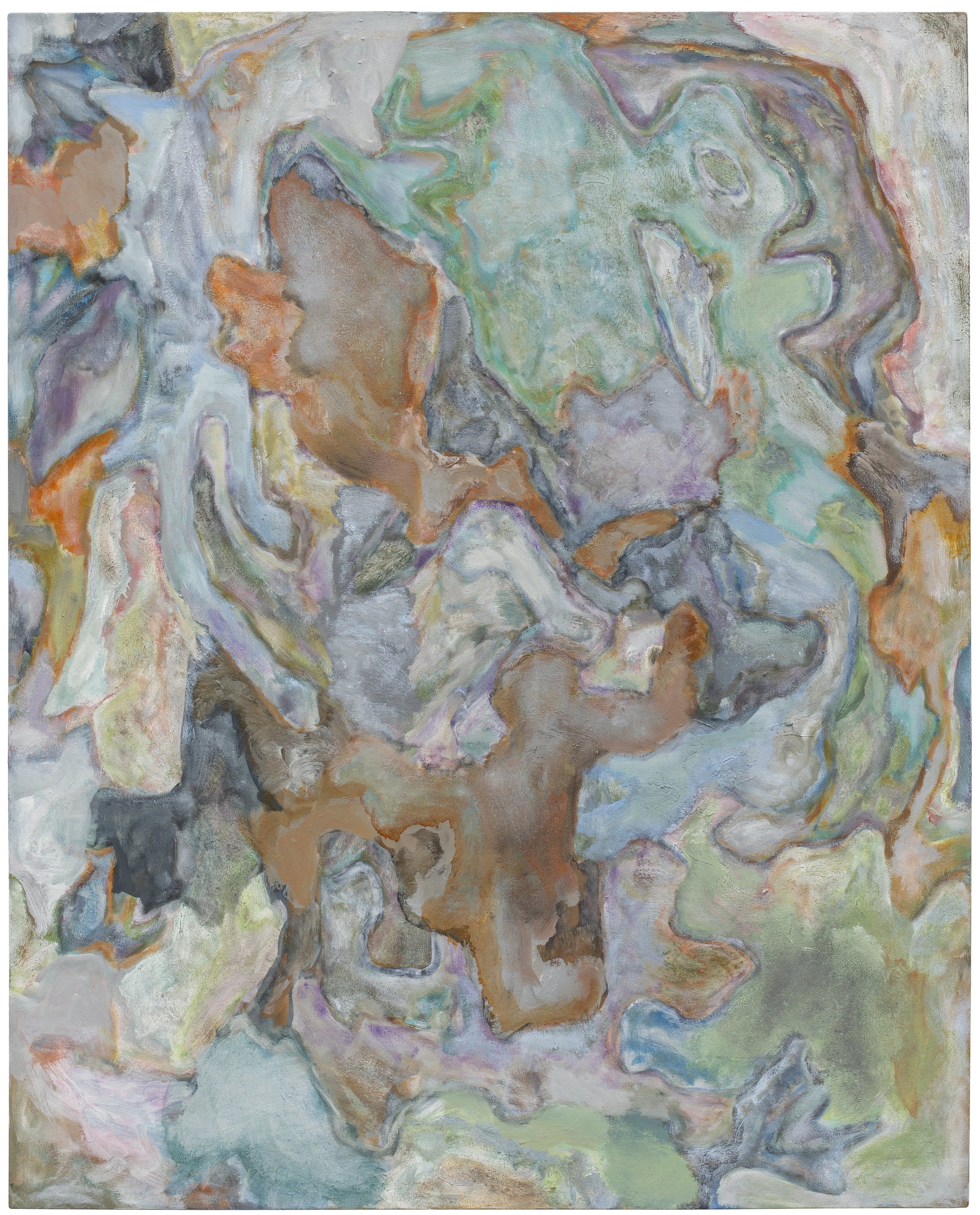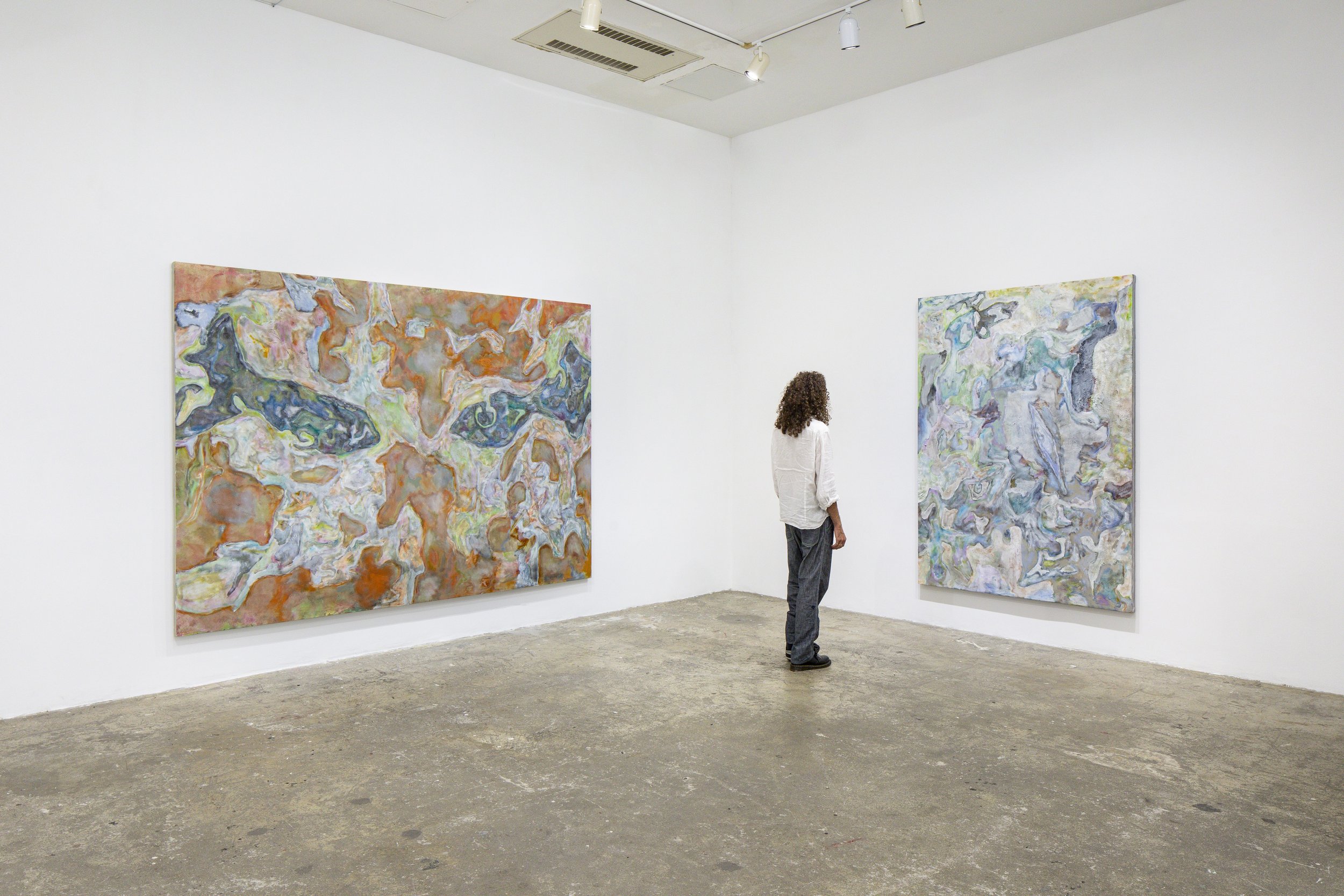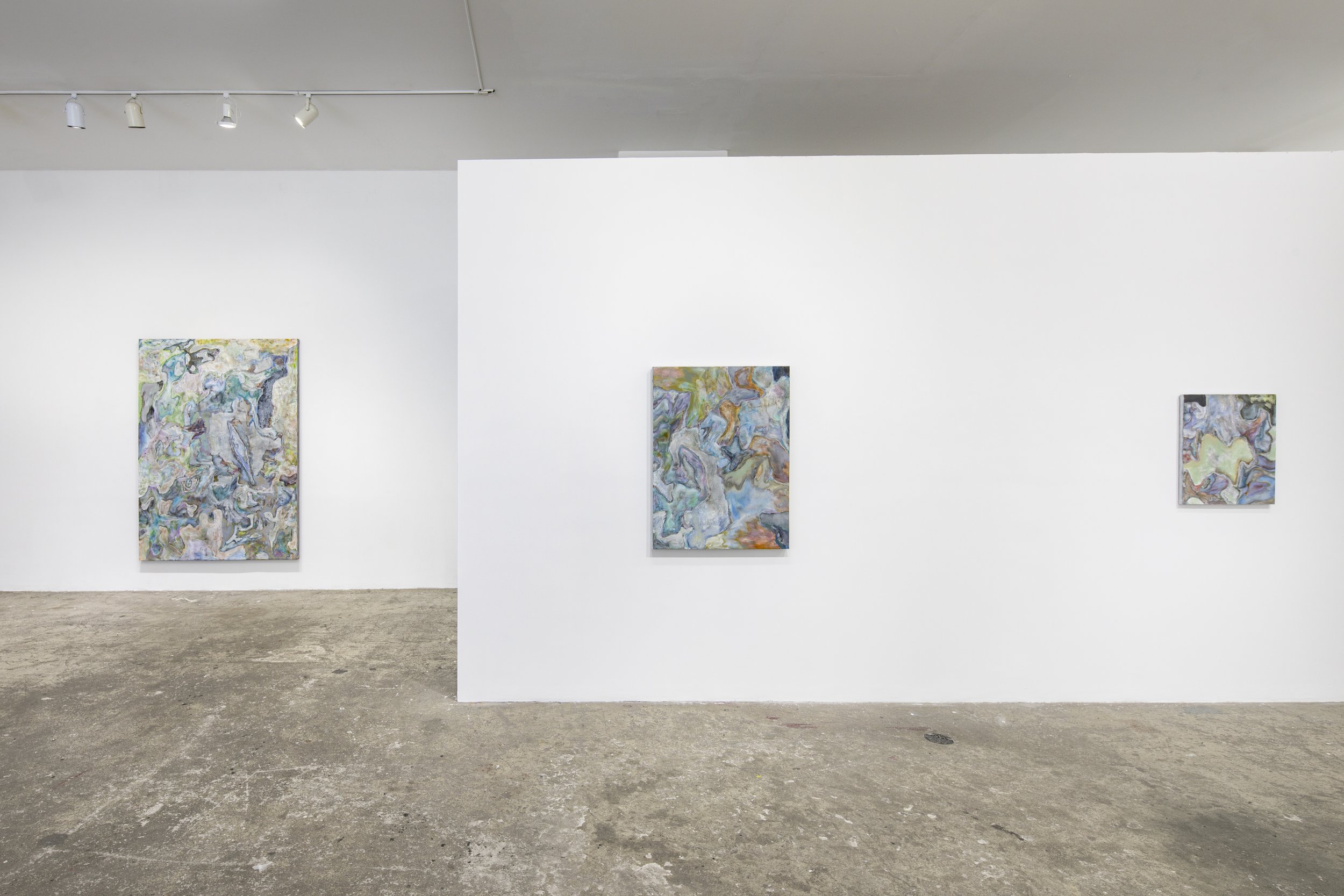Laurence Pilon | Benthic Ravers
July 13 – August 18, 2023
New York
Laurence Pilon | Benthic Ravers
July 13 – August 18, 2023
Sargent’s Daughters is pleased to present Benthic Ravers, the New York City debut exhibition of Montreal-based artist Laurence Pilon. Referring to the bottom of the ocean (or any other body of water), the term “Benthic” conjures images of shifting sediments and vast abyssal plains. This environment, where only faint rays of sunlight filter down to the depths, is populated by highly-specialized species of invertebrates, crustaceans, and fish. Pilon takes this alien landscape as their point of inspiration for a sweeping new body of abstract oil-on-canvas works, immersing viewers in the murky waters.
Pilon’s works are produced through an extended process of building up many layers of oil paint to create eroded, topographical compositions. The resulting abstractions dissolve any legible boundary between figure and ground, as amorphous forms blurr into one another. What appear to be subtle variations in surface color and texture resolve into psychedelic swirls when viewed from a distance. The cool grey-blues and green-browns of the ocean are present, but so are bolder shades of burnt umber, lime green, and pink. Pilon’s canvases might evoke the way sunlight refracts on the water’s surface, a branching coral, the skin of an iridescent fish, a vast underwater landscape – or simply an improvisational sensory impression.
For Pilon, the ocean, and the benthic zone in particular, is a site of profound enmeshment. Marine life, geology, and human action are all bound together in the gradual acidification and warming of the planet’s water systems. As this process has significant consequences for all life on Earth, it is a useful schema for understanding the interconnectedness of humans, animals, plants, and minerals in their various feedback loops. Though the benthic zone may appear totally alien, we impact and are impacted by what happens there. Understanding this allows for radical empathy with other life forms and environments, and has implications for how we might relate to other humans, whose lifeways or bodies seem unlike one’s own.
Laurence Pilon (b. 1990) is an artist based in Tiohtià:ke-Mooniyang (Montreal). They hold an MFA from the University of Guelph (2021), Ontario, CA and a BFA from Concordia University, Montreal, CA with Great Distinction (2015). Throughout their academic background, they received several awards including the Joseph-Armand-Bombardier Canada Graduate Scholarship (SSHRC, University of Guelph) and the Betty Goodwin Prize in Studio Arts (Concordia University), and their current program of work is supported by the Canada Council for the Arts. Their most recent solo exhibitions include A Scape Unnamed (Galerie Nicolas Robert, 2021), More-than-ghosts (Thesis exhibition, University of Guelph, 2021) and It Once Was a Garden (Galerie McClure, 2018).
Additional Reading for Benthic Ravers
BENTHIC RAVERS by Laurence Pilon
Whenever I heard:
save space by optimizing storage
I thought:
a new syndrome for guest users
a trial and error
a philosopher’s fantasy
Those are the kinder kind of lies we used to emulate to self-medicate with anhydrous simulacra
But like all the other tetrachromate dissociators who comply to digest
I fell for the sonic hues that again and again
are only begging for our rot
I zoned out and found myself staring at something that had emerged to burrow:
Feel better, fail better
Better to rejoice in illusory descent
then to disambiguate with vitalist excrescences
There's no need to beware of the ninth wave
Befriend your Cambrian trauma, your Devonian shutdown
There's a secret code for it
A mere ritual of planetary orchestration
which resists even the most honest gaze
What counts for passing?
I wonder
I dreamt of a kiss embedded in the concrete
And then, a sea of Petric saliva
Soon, hear the nacreous jaw, crawling through, sleeping not
Fake it 'til you'll never make it in time
I overheard
They’re in their abyssal era without a clue
A lazy formulation
a node to alkaline nostalgia
a Freudian dead zone
Take it off, all of it
Aqueous slippage like a pocket of bliss
CO2 + H2O -> (H+) + (HCO3-)
Your disk is almost full
Flickering: shut, open, shut, open, open, open, shut
When will the eyes crystalize too?
We did what we were told and we put our shells on acid
A tender plot of ruination murmured in a sinusoid footnote
Aragonite and proteins, queering
too busy unbeing dead
shapeshifting manically on the bathyal dancefloor
As we approach the dysphotic zone
Abrasive echolalia is my favourite response
Dissolve, dissolve, dissolve, dissolve
All there is left to do
is lay low and love
Amidst the raving benthos
NAVAL GAZING by Danielle St-Amour
Save space by optimizing storage
Of the spider crab’s adornment practices, one hypothesis suggests that they began as a ritual of sustenance. Consider two ancient members of the Inachinae family, Erileptus spinosus and Stenorhynchus seticornis. Observed at rest, they were seen to spread their long limbs in the shifting currents of mesoscale eddies, the tiny hairs on their legs capturing particles that they plucked and ate.
Majid crabs began, at some later but unknown point, to actively gather food and attach it to their hooked hairs, saving it for later consumption. Species like S. seticornis, Camposcia retusa, Pugettia prodigiosa, Podochela hemphilli, and Microphrys bicornutus have each demonstrated this behavior, turning their bodies into elaborate, living pantries.
Detach the spectator from the scene
Loxorhynchus crispatus is also called the moss crab, the masking crab, or the decorator crab. Their adornments aren’t intended for consumption by themselves or their predators. With bits of flora and fauna, flotsam and jetsam, human and non-human detritus, they interpret and mimic the ocean floor. An early study showed that even when their eye stalks were severed, or their retinas rendered opaque with thick paint, they were able to tell when they were uncovered. [1],[2]
Benthic ravers
Researchers exploring an underwater mountain off Panama's Pacific Coast found a dense cloud of sediment being booted up into the sea by swarming red crabs. They captured images and videos. In the densest areas, they recorded over 70 crabs per square meter. These 2.3 cm crabs moved together, jumping or swimming out alone or in pairs before rejoining the group. After hours of human observation, there were only two theories put forth on this phenomenon: the crabs were either mating, or eating.[3]
Naval-gazing
The benthic region is a midway point, where the heavy pressure of water meets the underneath, the earth. One can penetrate it at shallow depths, unadorned, or attempt to go deeper, in little metal ovals equipped with mechanized plucking claws, and spotlit, high-powered lenses. In both cases, however, visibility is poor; the light one desires is either heavily refracted, blurring, or too bright, rendering reality too sharp, forming a reflecting pool in which one might, and often does, lose track of the narrative.[4]
Flotsam, Jetsum, Lagan
[5] It’s possible that everything is becoming a crab. But as biologists will tell you, “not every crab is a crab.” There are false crabs and there are true crabs. Meanwhile, hubris-wrought vessels are imploding, voyeuristic eye-stalks are severing, and heavy, sea-bound vessels are capsizing, chomped and whacked at stern and bow, rendered moot by “unpredictable, unprecedented” activities of play—casings shed, becoming landscape.
The shell dissolves.
[1] Utopian Ernst Bloch, in response to a suggestion that art should reflect some kind of “unified reality,” responded with the question, “what if authentic reality is also discontinuity?”
[2] What if everything is becoming a crab? Carcinization is when a non-crab crustacean evolves into a crab-like form, which is an example of convergent evolution. It was introduced into evolutionary biology by L. A. Borradaile, who described it as "one of the many attempts of Nature to evolve a crab.”
[3] In the Puget Sound area of the northeast Pacific, a female orca from a group called “k-pod” was seen wearing a dead salmon around on her nose. Within weeks the behavior spread, with orcas from her own and two other pods wearing dead salmon hats. The fad ended abruptly. In “The Admission of the Inhuman” (Lana Turner Journal no. 7), Andrew Jorun asks, “Can anything cross the divide between nature and culture without being reduced to one or the other?” Jorun continues, “to the extent that not all social action is driven by self-conscious intentionality […], something of nature seeps, and even surges, through culture.”
[4] Stacey Alaimo writes, the “very eye that has opened up [this] world to the human species, has also allowed the human species to fold the world around its own, increasingly myopic, point of view.”
[5] Jorun closes, “Unless it opens to the unnameable, untameable flux of the Inhuman, text-centered practice cannot avoid systemic closure, cooling toward stasis and sterility.”





















